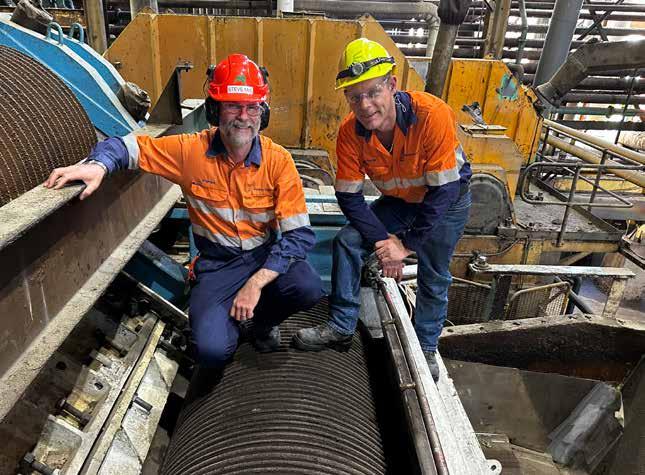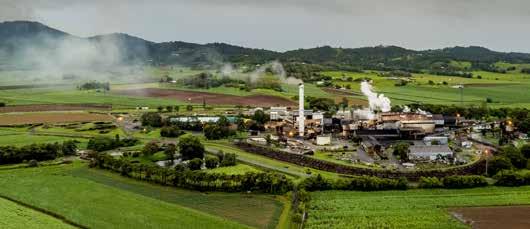
4 minute read
ROLL ARCING IS ON THE WAY OUT
In good news for the milling industry, significant steps have been taken towards an effective alternative to the conventional process of roll arcing, with both financial and health and safety benefits for the sector.
Why is this important?
Advertisement
Heavy rotating rollers are used in the mill to extract juice from sugarcane. The surface of the roll shells are covered with grooving to grip the sugarcane and drain the juice. The roll shells have traditionally been manufactured from grades of grey cast iron with a relatively rough surface, but to provide the necessary grip the surface must be further roughened. This has typically involved using chromium carbide hard surfacing electrodes which apply rough globules onto the roll surface. Flux cored wires are also widely used.
This is called roll arcing.
It is a labour-intensive process requiring regular reapplication. On the most heavily loaded rolls, such as the top roller, the reapplication frequency ranges from daily to fortnightly. Roll arcing also ties up a large number of boiler makers who could otherwise be repairing other items of plant and improving plant reliability.
It is also a significant health, safety and environment (HSE) risk. The boiler makers must work on or near high energy, rotating machinery, often in the presence of very hot vapour.
Contaminants and ultraviolet radiation in the welding process are known carcinogens. Welders must wear breathing masks and mills must use exhausts to remove the fumes from the mill building. Arcing during the crushing also means water (juice) and electricity (welding arc) are in close proximity, with the risk of electrocution.
The need to eliminate roll arcing has been on the research agenda since the early 1990s.
Cost effective alternative
A project - 2019/007 Eliminating Roll Arcing - funded by SRA and conducted by Chief Investigator, Queensland University of Technology’s (QUT) Geoff Kent, with partners Mackay Sugar and Wilmar Sugar, have investigated the availability of alternative equipment and processes and conducted trials to find the most cost-effective approach to eliminating roll arcing. Also partnering on the project was Australia’s national science agency, CSIRO, who developed the laser cladding technology.
Findings
1. Surface coating technology recommended for its service life and maintenance cost - the tungsten carbide technique.
“After a long incubation period, the tungsten carbide technique has now been taken up commercially in Australia,” Geoff Kent said.
“The welding company, Specialised Welding Products (SWP) and Bundaberg Walkers Engineering (BWEL) have applied the coatings in the sugar industry.”
2. Recommended roll shell material - SG iron
“A stronger, more durable and more weldable iron, SG iron, is now available on the market for a price not significantly different to grey cast iron,” Geoff said.
3. Investigated application
“The tungsten carbide chip surface was applied as a cladding on the tips while both the roots and the flanks of the grooves have also been clad to reduce undercutting and wear of the roll surface,” Geoff said.
“Undercutting is where the support for the tungsten carbide surface is weakened through wear over time and ultimately chunks of the grooves detach from the shell, leaving large cavities in the roll surface. Testing found that the amount of undercutting reduced using the SG iron shell material but the undercut region still needed to be repaired each season to avoid significant loss of roll diameter from the detachment of tooth sections.
“The roll diameter loss was similar to that expected from an arced, grey cast iron roll. However, because of the weldability of SG iron, the teeth could be readily rebuilt, using a low-cost steel welding consumable, and the tungsten carbide surface reapplied.”
4. Investigated technology - laser cladding
“Laser cladding consists of a portable 2 kW to 4 kW diode laser system, a robot manipulating the laser beam and a metal powder feeding system. The process uses minimal heat for faster cooling rates and much finer and denser microstructures than those produced by conventional processes,” Geoff said.
5. Recommended coatings and their expected life
Tip coating of mild steel containing tungsten carbide chips of particle size 16 to 20 mesh, applied by MIG welding
• Life: the single weld tip coating on the very tip of the grooves had to be replaced yearly for grip in the subsequent year and to restore the original outside diameter of the roll.
Flank coating of Tetra V420-G (a martensitic stainless steel, grade SAE 420), Robodur K600-G, a medium alloy martensitic steel with finely dispersed spherical carbides or Hardface HCO, a high chromium cast iron deposit containing primary chromium carbides in an austenitic matrix, applied by MIG welding
• Life: two to three years.
Root coating of austenitic stainless steel such as Tetra S 309L-G or Chromecore 309
• Life: same as the life of the roll.
“The combination of an SG iron roll and coating the roll grooves with hard facing using tungsten carbide chips was estimated to reduce overall costs of maintaining mill rolls by more than $500,000 per year,” Geoff said.
“Given this early stage of the technology’s development and the difficulty in quantifying all of the benefits, the potential saving is much greater.”
6. Recommended cost considerations
“Cladding technology was found to be more financially attractive than conventional arcing while MIG welding was more attractive than laser cladding,” he said.
More research to be done
“The issue of the failure of the upper flanks, causing detachment of the groove tips, has not yet been adequately addressed,” Geoff said. “Most surfaces last two to three seasons but then suffer tip detachment. Addressing this failure would significantly reduce refurbishment costs.
“Laser cladding is a promising technique as an alternative to MIG welding, allowing better controlled deposition of coatings with less heat, and expected to enhance the coating life. However, the technique requires much more development using higher powered lasers (20kW) to achieve more consistent deposition thickness on the inclined groove flanks and a much higher deposition rate.
Uptake by the mills
“The benefits of the cladding technology have been reasonably well established with a direct financial benefit which will increase when the likelihood of tip detachment is reduced. It is appropriate for application by all Australian sugar milling companies. So far, Tully Sugar, Wilmar Sugar Australia and Mackay Sugar have used the technology.
“Specialised Welding Products (SWP) now has considerable experience in the application of coatings, coating the trial rolls for Mackay Sugar and rolls for Wilmar Sugar Australia. SWP has established a workshop in Mackay.
“Bundaberg Walkers Engineering Ltd (BWEL) has also recently clad a new roll for Mackay Sugar in their Bundaberg workshop.
“The health, safety and environment (HSE) benefits have been quantified. While smaller than expected relative to other direct financial benefits, they are nonetheless attractive.”
Project progress has been reported annually at the Regional Milling Research Seminars, together with two workshops held in Townsville.
Tully Sugar, Wilmar Sugar Australia, Mackay Sugar, SWP and CSIRO have shared their experiences so that each milling company can develop their own plans for use of the technology.
“Any interested milling company can talk to SWP and BWEL or contact me at QUT,” Geoff said.









